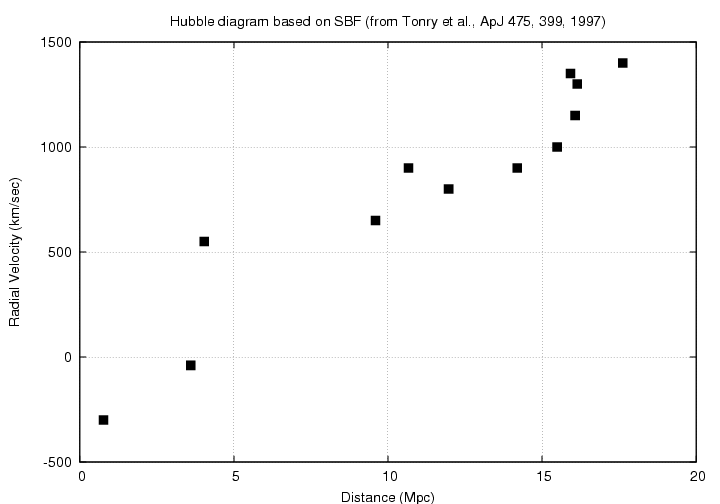Unfortunately, we have yet to discover any truly standard
"standard candle".
Here are some of the candidates scientists have
put forth over the years.
- Globular clusters: remember that a globular cluster
is a clump of thousands of stars, all packed together
into a small space.
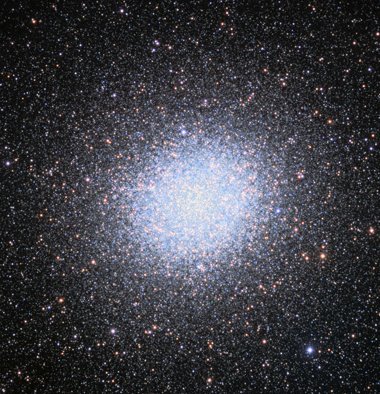
Image copyright
Thomas V. Davis
When we look at the globular clusters in our Milky Way,
we find that they span a large range in luminosity:
some are intrinsically very bright (because they have
lots of stars), and some are intrinsically very faint
(because they have few stars).
We can make a histogram of the luminosity function:
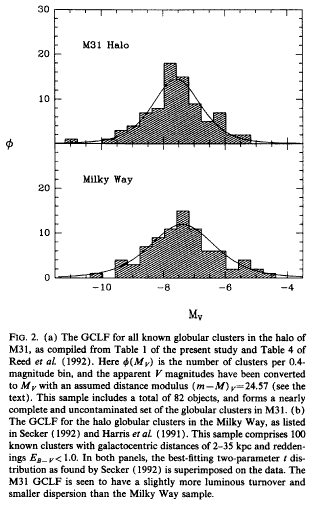
There are a few very bright clusters, a lot of "average"
clusters, and a few very faint ones.
Now, if we look at other galaxies, we can see globular clusters
around them, too:
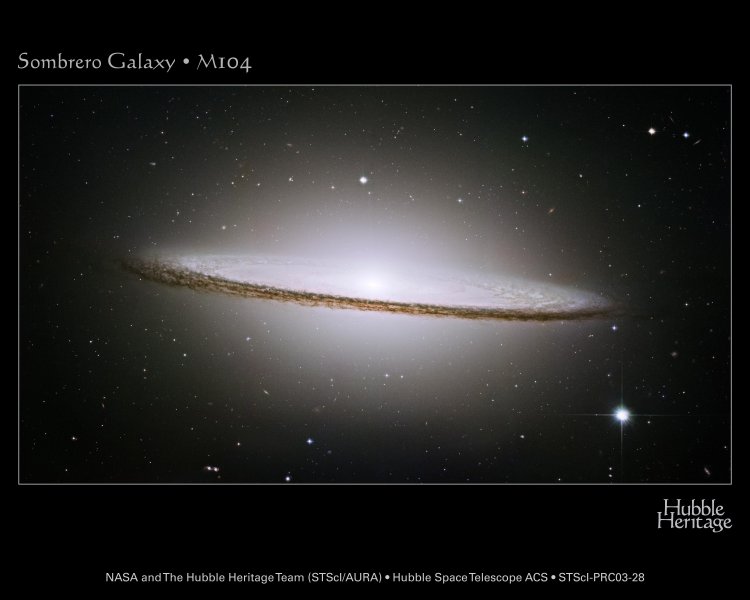
Let's zoom in for a closer look:

We can make histograms showing the brightness of their
globular clusters, too. For very nearby galaxies,
like Andromeda, this works pretty well. The amount
by which we need to shift the other galaxy's globular cluster
histogram in brightness to make it match our Milky Way's
tells us how far away it is (relative to the Milky Way).

But for really distant galaxies, we can only see the
very bright globular clusters:
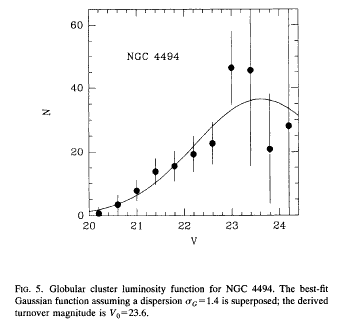
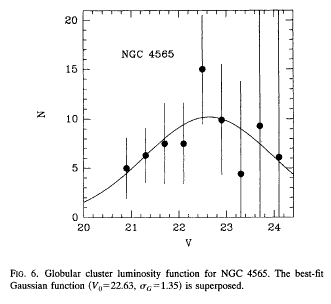
Trying to match these histograms against another galaxy's
histogram is really hard: if we can see the "turnover"
point (the "average" cluster), how can we match up
the peaks to find the shift?
Overall, this method only works for relatively nearby
galaxies: we can use it out at least as far as
the Virgo Cluster (about 20 Mpc).
I'm not sure that we can apply it out to the next big landmark,
the Coma Cluster (at about 100 Mpc).
- Type Ia Supernovae :
Supernovae are stars which explode, messily. They become
very, very luminous for a few short weeks, brighter than entire
galaxies, bright enough
that we can see them in very distant galaxies.
It would be great if all supernovae had exactly the same
peak luminosity, because they would make terrific standard
candles.
There are several mechanisms which can cause stars to explode.
Type Ia supernovae occur when, in a binary star system,
a main-sequence star dumps material onto a white dwarf companion:
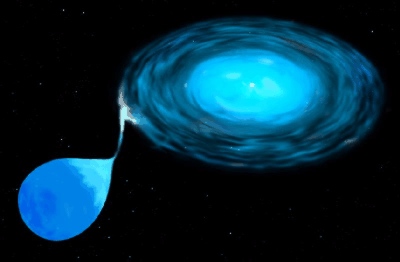
If the white dwarf accumulates enough material to push its
mass greater than about 1.4 solar masses, it explodes!
It brightens over a period of about two weeks, by a factor
of a million, and then fades slowly over several months:
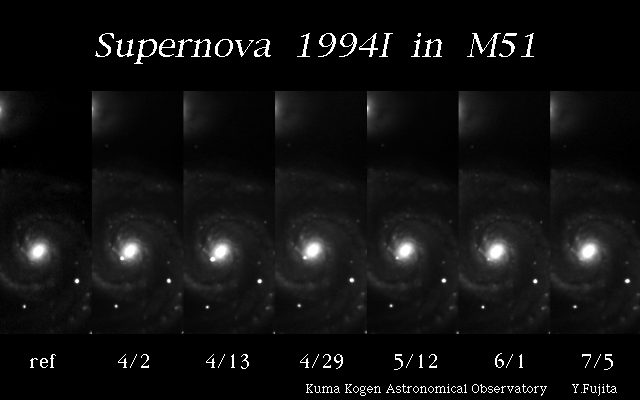

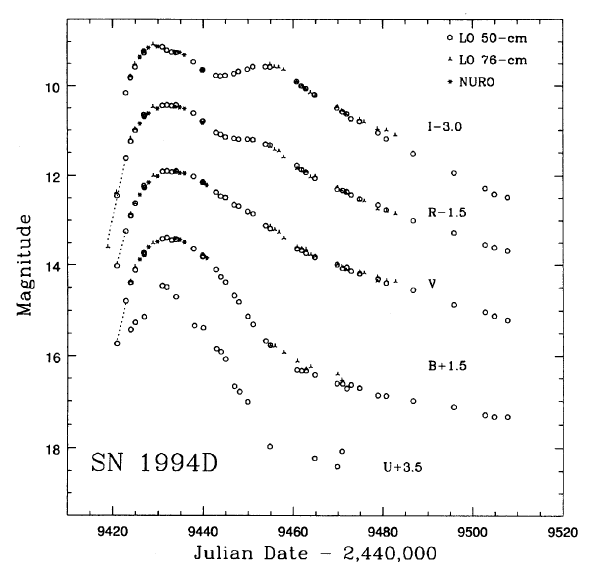
Since we think that all Type Ia supernovae occur when
this limit of 1.4 solar masses is reached, we think
that they all ought to have roughly similar peak luminosities.
Do they? Look at this graph of peak luminosity (on the vertical
axis) versus rate of decline after maximum (on horizontal axis,
with slow decliners at left and quick decliners at right):

Clearly, some Type Ia supernovae are brighter than others,
so they aren't standard candles. But it also appears that
the difference in peak brightness is correlated with the
rate at which they fade: slow faders are bright,
quick faders are faint. There's hope that we can correct
for the difference in peak luminosity by using the
rate of fading after maximum ....
Type Ia supernovae are probably the closest thing to a
standard-izable candle that astronomers have
at the moment, and they can be seen at VERY large distances.
Recent observations of very distant Type Ia supernovae
have hinted that funny things are going on in the very
distant universe ....
- Brightest Cluster Galaxy (BCG) :
One of the oldest methods is also the simplest:
it assumes that the brightest elliptical galaxy in a
big, rich cluster always has exactly the same
luminosity. Why? Good question. In my opinion,
this is an assumption of desperation:
when we look at VERY distant clusters, we can see
only the brightest galaxies, and measure few of them
with precision. Brightest cluster galaxies
are the only game in town...
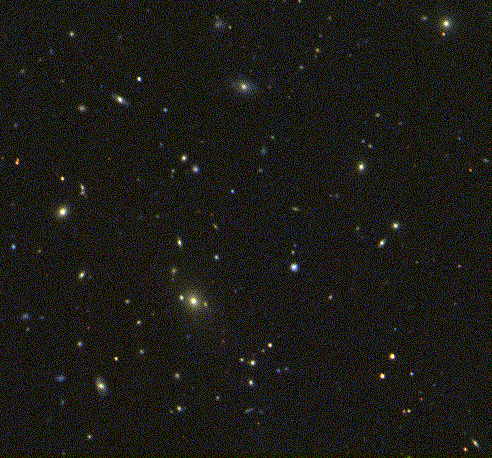
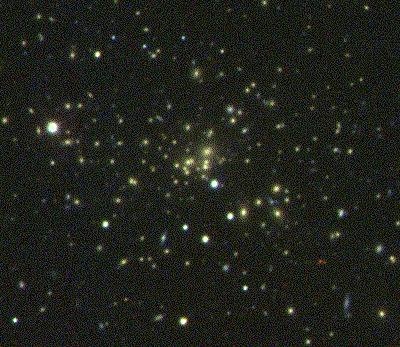
To be fair, there are indications that in many clusters,
the very brightest members really are quite similar.
For example, if all such galaxies really do have the same
luminosity, then they should fall in a straight line in
this diagram:

It appears that these galaxies are most similar if one
looks in the near-infrared, possibly because the obscuring
effects of any dust are minimized.
Overall, the BCG method is relatively imprecise (good to
only about 10 or 15 percent, at best, with careful selection),
but it can be used to very great distances.
- Surface Brightness Fluctuations (SBF):
Galaxies are made up of stars -- lots and lots of stars.
In nearby galaxies, we can make out individual stars:
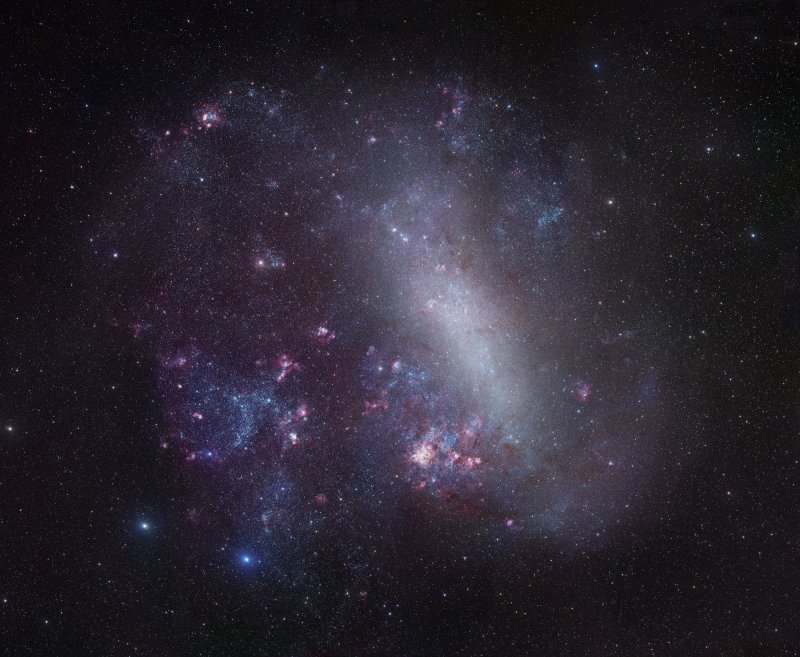
Image copyright
Robert Gendler
as you can see more clearly in a closeup:
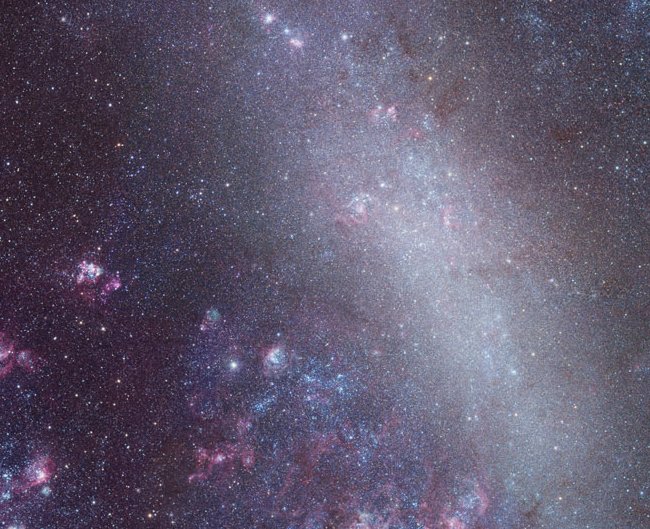
Image copyright
Robert Gendler
But in distant galaxies, the stars all blur together to form
what looks like a smooth bright area.
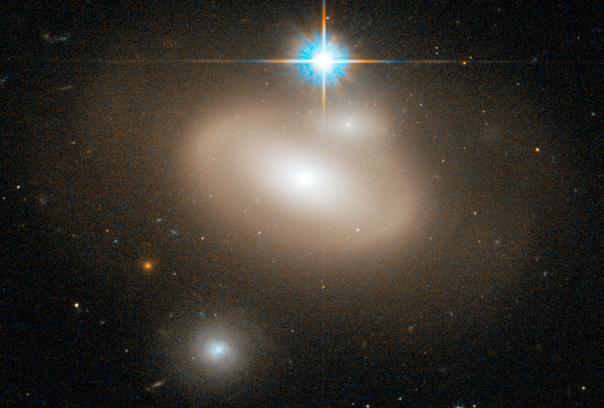
But if one looks very closely, one can see some "lumpiness"
in pictures of distant galaxies.
It's similar to the way that a smooth, nearly continuous
reproduction of a photograph breaks up into "lumps" if one
zooms in far enough:
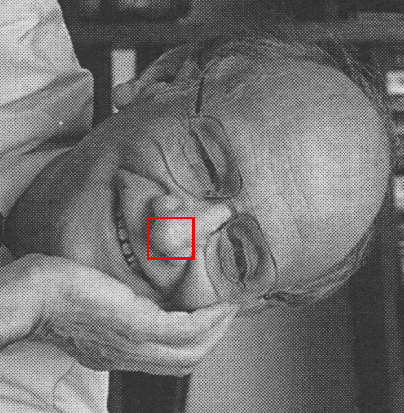




The amount of lumpiness gives us a clue to the galaxy's
distance:
- nearby galaxies are so lumpy we can distinguish
individual stars
- galaxies at intermediate distance are lumpy
- galaxies very far away are smooth
By measuring the size of the surface brightness fluctuations,
we can estimate the distance to a galaxy.
This method does assume that the stellar populations in all
galaxies (or maybe all elliptical galaxies) is very similar,
and that most of the "lumpiness" is due to old stars near the
peak of the red giant branch, and that the luminosity of those
stars in the red giant branch is the same in different galaxies.
That's a bunch of assumptions ... but it appears, empirically,
that they are often satisfied.
The SBF method can be used out to about 60 Mpc from the ground
(about twice as far as the Virgo cluster), and out to about
120 Mpc from space (about as far as the Coma cluster).
- Luminosity vs. Rotation:
Suppose that there are two galaxies, with identical shapes, sizes
and structures, but one (galaxy A) contains twice as many stars
as the other (galaxy B). Then we might expect:
- galaxy A should be twice as bright as galaxy B
- stars in galaxy A should feel stronger gravitational
forces than those in galaxy B, and so should
be moving around the center of the galaxy faster
It turns out that the factor by which stars move faster in
galaxy A is not simply "2"; instead, one can show with
some basic calculations that it's closer to a factor of
about sqrt(2), or 1.4.
But, whatever the factor is
(and, in real life, it's complicated by the range of sizes
of spiral galaxies), it's clear that more stars
should lead to faster motions.
A pair of astronomers named Tully and Fisher made a bunch
of observations to check this idea: they
measured
- the luminosity of a set of spiral galaxies
- the orbital velocities of stars in these galaxies,
based on the Doppler shift of lines in their spectra
When the compared the luminosities to the orbital velocities,
they found exactly the sort of relationship which the theory
predicts:
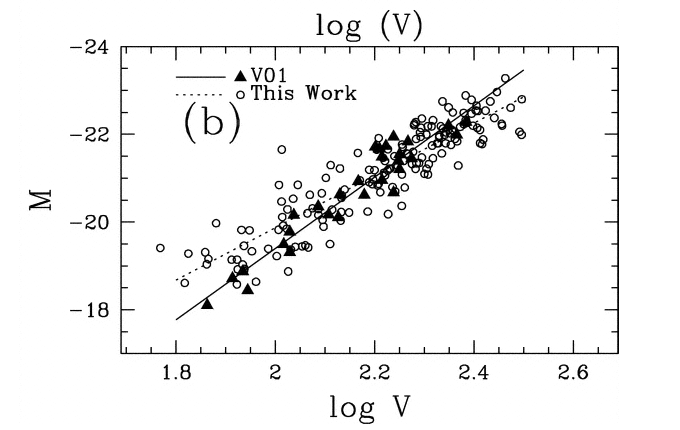
Taken from
Pizagno et al., AJ 134, 945 (2007)
Now, the relationship isn't a very tight one: there's a lot
of scatter.
That means that the Tully-Fisher method is imprecise:
it yields a distance to a single galaxy with an uncertainty
of about 20 percent.
On the other hand, spiral galaxies are common, so one might
hope to average the distances to many spirals in a single
cluster and find a precise distance to the cluster.
Example:
Joe Astro examines a spiral galaxy with both a radio
telescope and an optical telescope.
His radio telescope reveals motions of the gas
in the galaxy -- it has a rotation speed of
V = 300 km/sec .
His optical telescope measures the apparent
magnitude of the galaxy to be
M = 15.0 .
Q: What is the distance modulus to the galaxy?
Q: What is the distance to the galaxy in Mpc?

As part of tonight's experience, you will determine the
Hubble constant yourself!
Use this set of measurements of distances to relatively
nearby galaxies:














 Copyright © Michael Richmond.
This work is licensed under a Creative Commons License.
Copyright © Michael Richmond.
This work is licensed under a Creative Commons License.









